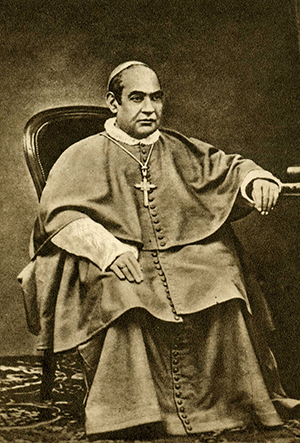ON ORDINARY TIMES
By Lucia A. Silecchia
Pope Leo XIV recently released the first extensive document of his papacy, “Dilexi Te,” an apostolic exhortation on love for the poor.
Almost immediately, pundits responded – some thoughtfully and others with partisan “hot takes” that pulled a mere line or two from the document to illustrate how it aligned perfectly with their viewpoints. Others turned immediately to critique, while some praised provisions they liked and ignored those they did not.

This did not surprise me. I have taught courses in Catholic social teaching and understand the instinct and temptation to view this teaching through political frameworks, ordering it to the “sides” we are used to taking.
Yet this exhortation warrants more. As an apostolic exhortation, “Dilexi Te” is less formal than an encyclical letter. Yet “exhortation” is an interesting term. Its root means “to encourage” or “to urge.” “Dilexi Te” is, therefore, encouragement or a summons to action. It is, in Pope Leo’s words, a summons to “appreciate the close connection between Christ’s love and his summons to care for the poor.”
In reading “Dilexi Te” and seeking to appreciate this “close connection,” three things challenged and – as an exhortation should – encouraged my heart most deeply.
First, the opening line, “I have loved you,” encourages prayerful reflection. It is traditional to name papal documents with the Latin translation of their opening words. Hence, “Dilexi Te” is simply the translation of the short sentence that launches the exhortation. Yet these four words (or two in Latin’s efficiency) convey a profound truth both fundamental to Christianity and largely unfathomable. To know that God says, “I have loved you,” can take a lifetime to ponder. “Dilexi Te” encourages readers to center their lives and relationships on this truth and to draw from it the inspiration for the love that should motivate care for those living with poverty.
Second, “Dilexi Te” encourages readers to see that many of our sisters and brothers live in poverty – and that this can take many different forms. Certainly, it includes material poverty. Yet “Dilexi Te” encourages a broader view. It invites readers to see that deep poverty can afflict those who suffer from many deprivations, including the sorrows of being “socially marginalized,” lacking “means to give voice to their dignity and abilities,” experiencing “moral,” “spiritual” or “cultural” poverty, being weak or fragile, or lacking “rights,” “space” or “freedom.”
Acknowledging poverty in this broader way invites and encourages us not to see “the poor” as merely “others” but to recognize that, in some way, each of us will know poverty sometime in our lives. To know this is to know deeper solidarity with those whose suffering might otherwise seem distant and easier to ignore.
Third, in what may be its most challenging yet encouraging section, “Dilexi Te” presents an extensive history of the church’s service to the suffering. The challenge embedded here is for each of us to join our ancestors in faith who lived lives in so many ways of loving service. They recognized, as Pope Leo explained, that “no sign of affection, even the smallest, will ever be forgotten, especially if it is shown to those who are suffering, lonely or in need.”
Pope Leo described the service missions of the earliest deacons of the church, who served those in need. He then pointed to some of the earliest Church Fathers – including the familiar Saints Ignatius of Antioch, Justin, John Chrysostom, Ambrose and Augustine – who taught vehemently about serving the poor and seeing how intimately intertwined are love of God and love of neighbor.
This cannot remain mere theory. Pope Leo continued by describing how care of the sick and suffering has, through the centuries, been close to the heart of the church. This has been accomplished both through the leadership of well-known saints and through the love of so many religious women who labored anonymously through the ages to offer “comfort, a listening ear, a presence, and above all, tenderness” to those in their care.
Pope Leo spoke of the generous hospitality offered by those in monastic life, under the guidance of Saints Basil the Great, Benedict of Norcia and Bernard of Clairvaux. He spoke of leaders who established religious orders to minister to those who were captured and suffering imprisonment – and of their followers, whose names may be remembered only by God. He also highlighted the ways in which religious orders such as the Franciscans, Dominicans, Augustinians and Carmelites embraced poverty for the sake of bringing others closer to God.
At length, Pope Leo spoke of orders founded in more recent centuries to offer education as a particular way of assisting those in need. He again acknowledged the often underappreciated work of women religious who devoted their lives to this, recognizing knowledge as both a “gift from God and a community responsibility.” In a similar way, he acknowledged the labors of religious orders who cared for those who migrate and those who ministered to “the poorest of the poor.” He also acknowledged those who lived lives in service to persons living with disabilities of all kinds.
This journey through the centuries is not merely a history lesson. It is an invitation to see this radical caring love as integral to our faith.
Because “Dilexi Te” is a new document from a new pope, it will get much attention. But more than attention, it deserves reflection on what it tells each of us – not others – to do. And, at its heart, it encourages us to love others as God has loved us, in all the days of our ordinary times.
(Lucia A. Silecchia is Professor of Law at the Catholic University of America’s Columbus School of Law. “On Ordinary Times” is a biweekly column reflecting on the ways to find the sacred in the simple. Email her at silecchia@cua.edu.)







